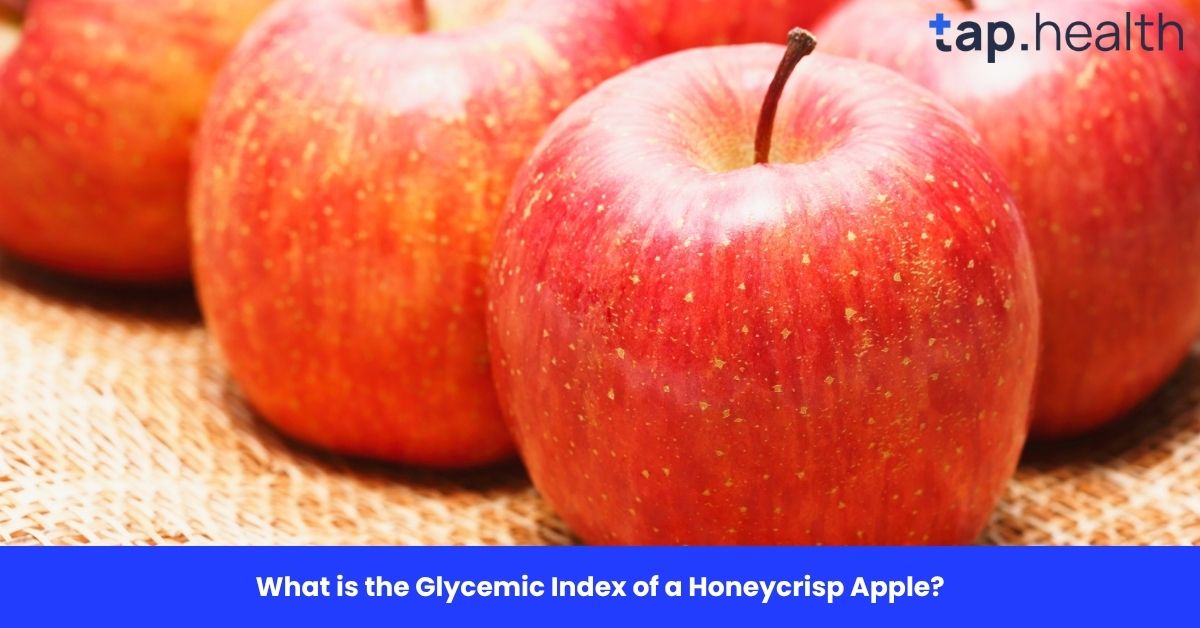When it comes to maintaining a healthy diet, the glycemic index (GI) of foods plays a crucial role. The glycemic index measures how quickly a food raises blood sugar levels. It’s a handy tool for those managing conditions like diabetes or simply trying to make healthier choices. Among the many fruits that are commonly enjoyed, the Honeycrisp apple is a popular choice. In this article, we’ll explore the glycemic index of a Honeycrisp apple, its health benefits, and how it compares to other types of apples. We’ll also dive into other important questions that people have regarding this delicious and nutritious fruit.
What is the Glycemic Index?
The glycemic index is a scale that ranks foods based on how they affect blood sugar levels. It measures how quickly carbohydrates in food break down into glucose (sugar) and enter the bloodstream. Foods are classified into three categories based on their glycemic index:
- Low GI (55 or less): These foods raise blood sugar slowly and steadily. Examples include whole grains, legumes, and most fruits.
- Medium GI (56–69): These foods cause a moderate rise in blood sugar. Examples include whole wheat products and some types of rice.
- High GI (70 or more): These foods cause a rapid spike in blood sugar. Examples include white bread, sugary snacks, and processed foods.
The lower the glycemic index, the less impact a food will have on your blood sugar, which is particularly important for people with diabetes.
What is the Glycemic Index of a Honeycrisp Apple?
The glycemic index of a Honeycrisp apple typically falls in the low GI category. It ranges between 36 to 40, making it a great option for those looking to maintain stable blood sugar levels. This low glycemic index is a result of the apple’s natural sugars and high fiber content, which work together to ensure that sugar is released slowly into the bloodstream.
Why is the Glycemic Index Important for Honeycrisp Apples?
The GI of Honeycrisp apples is important because it helps those with diabetes or insulin resistance manage their blood sugar levels more effectively. Eating foods with a low GI, like the Honeycrisp apple, can help avoid blood sugar spikes, which is crucial for overall health and preventing complications related to diabetes.
also read this: How Many Calories in a Honeycrisp Apple?
How Does the Glycemic Index of a Honeycrisp Apple Compare to Other Apples?
When compared to other apple varieties, Honeycrisp apples have a relatively low glycemic index. Here’s a comparison with some common apple types:
- Honeycrisp Apple: Glycemic Index of 36–40
- Granny Smith Apple: Glycemic Index of 38
- Red Delicious Apple: Glycemic Index of 40
- Fuji Apple: Glycemic Index of 42
- Golden Delicious Apple: Glycemic Index of 42
As you can see, Honeycrisp apples are on the lower end of the glycemic index scale, which makes them a great choice for maintaining steady blood sugar levels.
Health Benefits of Eating Honeycrisp Apples
Apart from having a low glycemic index, Honeycrisp apples offer numerous health benefits. They are not only delicious but also packed with nutrients that contribute to overall well-being.
1. Rich in Fiber
Honeycrisp apples are an excellent source of dietary fiber, which plays a key role in digestive health. The fiber in apples helps promote regular bowel movements, prevent constipation, and support a healthy gut microbiome. It also contributes to feelings of fullness, which can help with weight management.
2. Boosts Heart Health
The fiber, antioxidants, and flavonoids in Honeycrisp apples can contribute to heart health. These components help reduce bad cholesterol (LDL) levels, lower blood pressure, and improve overall cardiovascular health. Eating apples regularly has been associated with a reduced risk of heart disease.
3. Supports Weight Management
Because of their high fiber content and low glycemic index, Honeycrisp apples are a great snack for those trying to maintain or lose weight. The fiber helps keep you full longer, reducing the likelihood of overeating. The low GI ensures that the sugar from the apple is released gradually, providing sustained energy without causing blood sugar spikes.
4. Packed with Vitamins and Minerals
Honeycrisp apples are rich in essential vitamins and minerals, such as Vitamin C, which helps strengthen the immune system, and potassium, which is important for maintaining proper nerve and muscle function. Apples also provide small amounts of B-vitamins like riboflavin and thiamine.
5. Contains Antioxidants
Antioxidants are compounds that help protect the body from harmful free radicals. Honeycrisp apples are packed with antioxidants, including flavonoids, which have been shown to reduce inflammation and oxidative stress. These antioxidants may also help protect the brain and prevent neurodegenerative diseases.
How to Incorporate Honeycrisp Apples into Your Diet
Adding Honeycrisp apples to your daily diet is easy and enjoyable. Here are some simple ways to include them in your meals:
- Eat Them Fresh: The simplest way is to enjoy a fresh Honeycrisp apple as a snack. You can slice it and pair it with peanut butter or almond butter for added protein and healthy fats.
- Apple Salads: Slice Honeycrisp apples into your salads for a sweet and crunchy texture. Combine them with leafy greens, nuts, and cheese for a balanced meal.
- Smoothies: Blend Honeycrisp apples into smoothies for natural sweetness. Pair with ingredients like spinach, berries, yogurt, or oats for a nutritious drink.
- Baked Goods: Honeycrisp apples can be baked into pies, cakes, and muffins for a healthier dessert option. The natural sugars in the apple reduce the need for added sweeteners.
Are Honeycrisp Apples Good for People with Diabetes?
Yes, Honeycrisp apples are a good choice for people with diabetes due to their low glycemic index. They provide a steady release of glucose into the bloodstream, preventing sharp blood sugar spikes. The fiber content also slows the absorption of sugars, making them a safe fruit option for individuals managing blood sugar levels.
However, as with any food, moderation is key. It’s always a good idea for people with diabetes to consult a nutritionist or healthcare provider to understand the best way to incorporate apples into their diet.
Other Considerations for Eating Honeycrisp Apples
While Honeycrisp apples offer many health benefits, it’s important to note that eating them in excess can still contribute to an increase in overall calorie intake. If you are watching your weight, it’s best to consume them in moderation, just like any other fruit.
Additionally, it’s important to wash apples thoroughly before eating them to remove any pesticides or contaminants that may be on the skin. Opting for organic apples can help reduce exposure to pesticides.
Frequently Asked Questions (FAQs) on What is the Glycemic Index of a Honeycrisp Apple?
1. What is the glycemic index of a Honeycrisp apple compared to other fruits?
The glycemic index of a Honeycrisp apple is around 36–40, which is lower than many other fruits. For example, bananas have a glycemic index of 51, and watermelon has a glycemic index of 72. Honeycrisp apples are a great option for maintaining steady blood sugar levels.
2. Are Honeycrisp apples good for weight loss?
Yes, Honeycrisp apples are an excellent option for weight loss. They are low in calories and high in fiber, which helps promote feelings of fullness and reduces the likelihood of overeating.
3. Can I eat Honeycrisp apples if I have diabetes?
Honeycrisp apples are a good choice for people with diabetes because they have a low glycemic index and high fiber content. They help prevent rapid blood sugar spikes, making them a safe and healthy option for people with diabetes.
4. Do Honeycrisp apples contain a lot of sugar?
While Honeycrisp apples do contain natural sugars, their glycemic index is low, meaning that the sugars are released gradually into the bloodstream. This helps prevent blood sugar spikes. The amount of sugar in one apple is generally not a concern when consumed in moderation.
5. What makes Honeycrisp apples different from other apples?
Honeycrisp apples are known for their balance of sweetness and tartness, making them a favourite among apple lovers. Their unique texture is crispy and juicy, offering a satisfying crunch. They also have a lower glycemic index than many other apple varieties.
6. Are Honeycrisp apples better than other apples for digestion?
Honeycrisp apples are rich in fiber, which helps with digestion. The fiber content in Honeycrisp apples aids in regular bowel movements and supports a healthy gut. While all apples contain fiber, Honeycrisp apples are particularly beneficial due to their high water content and fiber composition.
Conclusion
The glycemic index of a Honeycrisp apple, ranging from 36 to 40, places it in the low GI category, making it an excellent choice for those looking to manage their blood sugar levels. Whether you’re looking to improve heart health, manage weight, or simply enjoy a tasty and nutritious snack, Honeycrisp apples offer numerous health benefits. With their crisp texture, sweet-tart flavour, and rich nutrient profile, they’re a great addition to any diet.



